I am working on a new 1890’s pattern, so as inspiration, here is a free article for you that I transcribed from the Ladies Home Journal, November, 1898. I hope these provide you with inspiration for making little accessories to keep you warm in the upcoming months!

 ny one of the pretty muffs or collarettes shown on this page will prove a welcome Christmas present to either, wife, mother, sister or friend. The pretty set made of astrakhan cloth, shown in the illustrations, will be found easy to reproduce.
ny one of the pretty muffs or collarettes shown on this page will prove a welcome Christmas present to either, wife, mother, sister or friend. The pretty set made of astrakhan cloth, shown in the illustrations, will be found easy to reproduce.
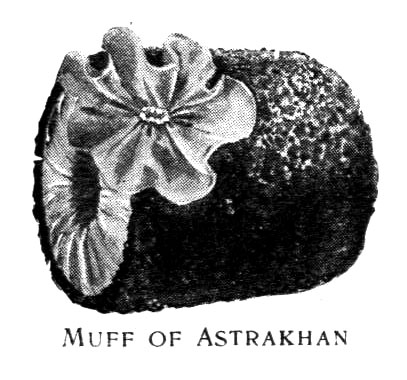
The muff is of the cloth, and made over a shape ; it is lined with silk of the new blue shade, and at one side is a rippled rosette with a tiny Rhinestone buckle in the center.
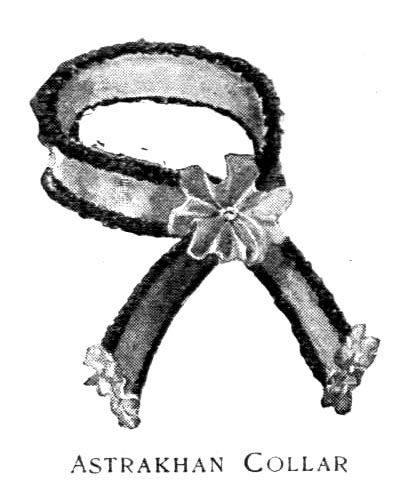
The band for the neck is of blue velvet, piped with the astrakhan, and where it is crossed is a scant rosette of the velvet with the buckle in the middle. Rosettes finish each end.
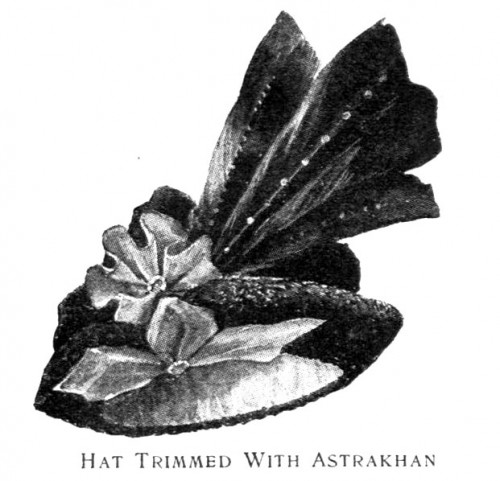
The hat has the crown and brim of astrakhan, the cloth being drawn closely over one of the new shapes to be worn off the face. The broad spangled quills are caught in place by a velvet rosette, and a clover bow, also of the velvet, is under the brim so that it rests on the hair just in front.
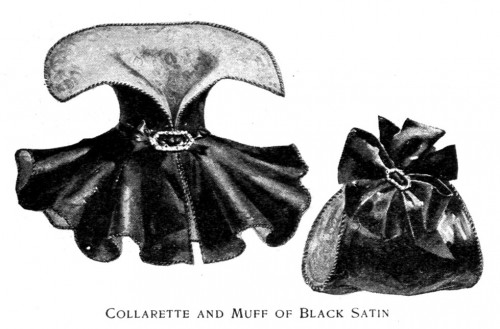
The rather elaborate set of black satin in illustrations, shows a flaring Medici collar of black satin lined with figured silk in light colors. The edges of both collar and muff are outlined with a cord of heavy black and white silk. The collar flares well away from the throat, which it should be made to fit, while the cape part is laid in flaring bloc-plaits. At the neck is a narrow black ribbon, lopped in a tiny bow in the front under a Rhinestone buckle. The muff, a veritable bag shape, is of material like the cape. It is drawn together at the top under loops of ribbon, and a small strass buckle is in the center. If one prefers it a piping of fur or satin may be substituted for the cord, but the cord is the newest in style.
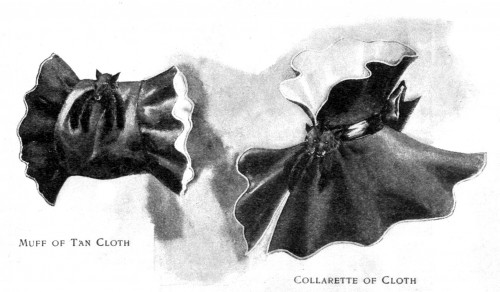
The simple but elegant-looking muff of tan cloth is made of cloth matching the gown. It is semi-oval in shape and lined with cream Bengaline, the sides being arranged in scant frills that permit the lining to show. In the center is a small fur head, from under which fall four fur tails, all being one of the dark shades. A muff made in this way may be worn with any gown provided always that it match sin color, and that the lining of the frills is selected with an eye to that prevailing in the costume.
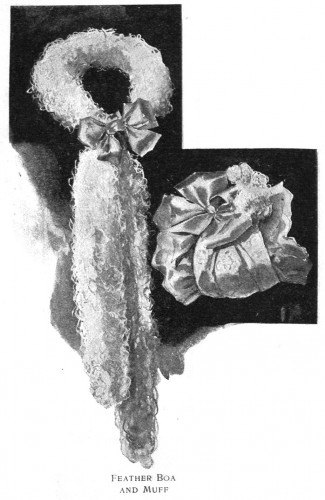
Any woman who has many tiny tips- white ones- left from this hat and that wrap, may hie herself to the dealer in feathers, and by cleansing those already possessed and adding a few to them she may make a dainty boa, the one which may be fastened at the throat with a bow of white satin ribbon, with its loops and ends “fixed” after the very latest fashion. To go with this there is the muff made of broad figured ribbon and finished at each side with frills of ribbon to match. A gig bow of plain white satin is on top, contrasting well with a compile of tiny white feathers just beside it. In appearance this set is elaborate. There will be but a very little money gone from one’s purse, through the usage of wisdom and the combination of good taste will be great to create this pretty and stylish belonging.
There are many attractive belongings that do not cost as much money as time and dexterity, and that deftness that is really a talent. Most of us can make our muffs and collars, otherwise there would be many more cold hands and sore throats. The cape collar of cloth, shown in illustration, which may be worn over the coat or without it, has a slightly curved air. It is lined throughout with the Bengaline, the shaping of the collar showing the lining. Around the neck, making a distinction between collar and cape, is a folded band of black satin ribbon arranged in a full bow at the back, wile in front, as if they were clasps, are two fur heads with several small tails falling from under them. A more expensive cape of this kind, suited for mourning, would be one of crape lined with dull silk, and trimmed with ribbon and astrakhan heads.
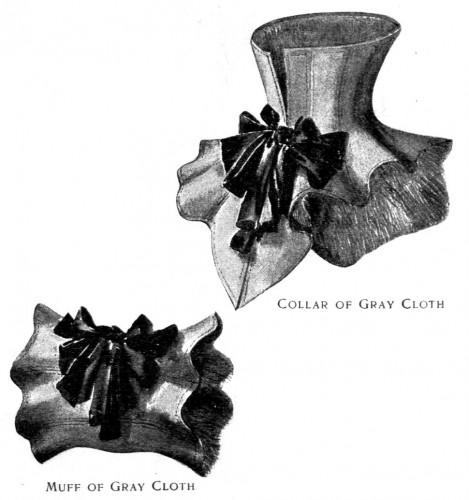
A most stylish set is the cloth one shown in illustrations. It is made of gray cloth, although any shade matching the gown may be used. The collar, as well as the muff, is made of shaped pieces tailor fashion, the stitching on the right side being done at each section and around the edges with heavy silk. There is a decided flare given to the muff at each side, while dark crimson velvet bows graduated in size are at the top and fall well forward. The collar has a cape that ripples slightly, but the very high collar is straight, the stitching on it being very conspicuous. The cape is short on the shoulders and comes to a decided point in front, its fastening being concealed under many loops of crimson velvet. Both muff and cape are lined with an inexpensive gray fur which adds to their comfort as well as to their beauty.
Next to shaping one’s muff the greatest care must be taken to make the layer of cotton, really the layer, give not only the soft, full loop, but all vicissitudes in the shape of “lumps” of wadding must be straightened out. The cloth muff, which is specially appropriate for the fur-trimmed cloth gown, will obtain this season.
There are many inexpensive furs, in bands, heads or tails, that are effective on the muff or collar and yet add but little to the cost. Often the bust little woman who goes out by the day, sewing busily and with many a bright idea, since she is interested in her patrons, will evolve a muff form almost nothing. One recently seen was oval-shaped, made of a bit of black brocade left over from a dress, lined with coarse white silk that was new but did not cost much, while on tip, from among loops and ends of ribbon- also new- hung tiny tails of ermine- entire cost, three dollars. But the buyer of the materials for this very stylish muff understood that there were small, almost unknown, shops where a bit of fur or of pasesmenterie could be bought at a reasonable price.
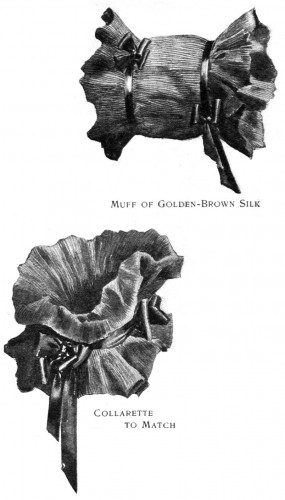
Something absolutely new is shown in the silk collar and muff in the illustrations. They are made of soft, thin, golden-brown silk laid in accordion plaits pulled out as illustrated. Satin ribbon bows in bands and loops make an effective contrast, the ribbon upon the collar being little wider than that upon the muff.
All the muffs and collars illustrated upon this page are inexpensive, and any one of them may be made by the so-called “handy” woman, with an ease that will surprise even herself. Other materials than those suggested here may be substituted, the only absolute requirement being that both the muff and collar shall be made soft and warm.

Kura
January 2, 2014 at 12:24 pm (12 years ago)A flaring Medici collar! Add that to the list of ‘must make’ :) Thanks for sharing
Lauren
January 2, 2014 at 1:44 pm (12 years ago)Hurrah! If you make it, please share a picture!
Lady Lavender
January 2, 2014 at 12:48 pm (12 years ago)I absolutely love muffs! In my opinion, they leave your hands available for use unlike gloves that might need to be taken off for a particular task. But as soon as you’re ready to, you can slip your hands straight back into the warmth of the muff. I heard that some muffs can even have pockets to insert hot stones into so that on a cold trek to somewhere your hands will always be warm. Thanks for sharing this inspirational post!
Also, do you happen to know what exactly is “astrakhan”?
Lauren
January 2, 2014 at 1:43 pm (12 years ago)I’m so glad you like it!
Using hot stones is BRILLIANT! I love that idea!
I believe astrakhan is the fur that is from baby sheep. It’s also called “curly lamb”. I don’t know why it’s referred to as a “cloth” in the article, though! I believe you can get faux curly lamb, which is much more humane :)
Sandi
January 11, 2014 at 7:25 am (11 years ago)I have some vintage astrakhan cloth (I wouldn’t want the real deal, as I have seen how it is obtained, and it’s not nice!)
Although the pieces that I have are narrow, I was thinking of sewing them together to make a muff, as I too love hand muffs!